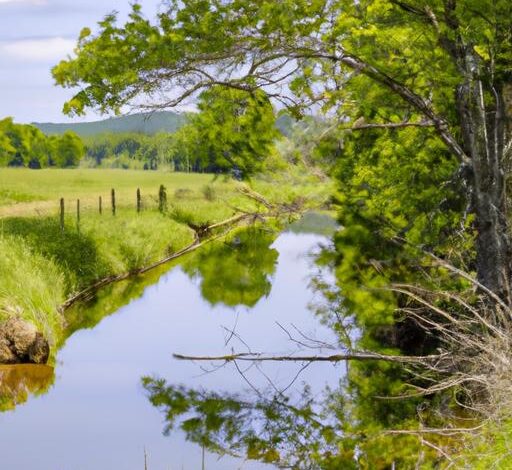Exploring the Wonders of Tennessee Wildlife Management Areas

Welcome to the enchanting world of tennessee wildlife management areas (TMWAs). In this article, we will embark on a captivating journey, delving deep into the significance, biodiversity, and historical establishment of these remarkable areas. So, fasten your seatbelts and get ready to explore the wonders that TMWAs have to offer.
1. Introduction to Tennessee Wildlife Management Areas (TMWAs)
Imagine a place where wildlife thrives in harmony with nature, where lush forests, sparkling rivers, and rolling hills create an idyllic haven for countless animal species. This is precisely what TMWAs strive to achieve – the preservation and management of wildlife in the beautiful state of Tennessee.
A. Importance of TMWAs in preserving and managing wildlife
TMWAs play a pivotal role in safeguarding and conserving Tennessee’s diverse wildlife. These areas act as sanctuaries, providing habitats where wildlife can flourish undisturbed. By implementing effective management strategies, TMWAs ensure the survival of native species and protect them from the threats posed by human activities.
B. Overview of the diverse ecosystem found in TMWAs
Within the sprawling expanse of TMWAs, nature unveils its magnificent tapestry of life. From the majestic deer roaming freely to the graceful flight of migratory birds, these areas offer a glimpse into the captivating world of Tennessee’s wildlife. The rich ecosystem found in TMWAs includes an array of plant and animal species, each playing a vital role in maintaining the delicate balance of nature.
C. Brief history and establishment of TMWAs
The establishment of TMWAs can be traced back to a time when the need for wildlife conservation became apparent. Tennessee recognized the importance of preserving its natural heritage and took significant steps to create these management areas. Through the dedication of organizations and the collaboration of passionate individuals, TMWAs came into existence, marking a milestone in the state’s commitment to wildlife preservation.
As we continue our expedition through the remaining sections, we will delve into the benefits and role of TMWAs, their locations and size, the remarkable wildlife diversity they harbor, the recreational opportunities they offer, and the management and conservation efforts undertaken to protect these precious areas.
Get ready to be enthralled by the wonders of Tennessee’s wildlife management areas. Together, let’s uncover the secrets they hold and appreciate the invaluable role they play in safeguarding our natural heritage.
2. Benefits and Role of TMWAs in Tennessee
Tennessee Wildlife Management Areas (TMWAs) serve as beacons of hope for the preservation and protection of the state’s natural heritage. Let’s dive deeper into the remarkable benefits and roles these areas play in Tennessee’s ecosystem.
A. Conservation of native wildlife species
TMWAs are instrumental in conserving and nurturing native wildlife species that call Tennessee home. These areas provide a safe haven for endangered and threatened species, allowing them to thrive and recover their populations. By implementing comprehensive management plans, TMWAs ensure the survival of these species for generations to come.
From the elusive red wolves to the majestic bald eagles, TMWAs serve as vital habitats, supporting the intricate web of life that exists within their boundaries. Through active monitoring, research, and protection measures, these areas contribute significantly to the conservation efforts of Tennessee’s unique and precious wildlife.
B. Preservation of natural habitats
The preservation of natural habitats is a cornerstone of TMWAs. These areas encompass a diverse range of ecosystems, including forests, wetlands, grasslands, and water bodies. By safeguarding these habitats, TMWAs create a haven for countless plant and animal species, preserving the delicate balance of nature.
Within the lush forests of TMWAs, you’ll discover a symphony of life, from towering trees providing shelter to elusive creatures, to delicate wildflowers painting the landscape with vibrant hues. These habitats are not only crucial for the survival of native wildlife but also for maintaining the ecological processes that ensure the health and sustainability of Tennessee’s natural environment.
C. Opportunities for outdoor recreation and education
In addition to their conservation efforts, TMWAs provide ample opportunities for outdoor recreation and education. Whether you’re an avid hunter, angler, hiker, or wildlife enthusiast, these areas offer a plethora of activities for all to enjoy.
Hunters can embark on thrilling expeditions, seeking game species such as deer, turkey, and waterfowl. Anglers can cast their lines into pristine rivers and lakes, hoping for a prized catch. Hikers can explore the network of trails, immersing themselves in the breathtaking beauty of Tennessee’s wilderness.
Moreover, TMWAs serve as living classrooms, offering educational programs and events that foster a deeper understanding and appreciation of the natural world. From guided nature walks to interactive wildlife exhibits, these areas provide valuable opportunities for individuals of all ages to connect with nature and learn about the importance of conservation.
As we move forward, we’ll uncover the locations and sizes of TMWAs, the remarkable wildlife diversity found within these areas, and the thrilling recreational activities they offer. Get ready to be amazed by the wonders that await in Tennessee’s wildlife management areas.
Location and Size of TMWAs in Tennessee
A. Geographical distribution of TMWAs across the state
Tennessee Wildlife Management Areas (TMWAs) are strategically scattered throughout the state, offering a diverse range of habitats and ecosystems for wildlife to thrive. From the rolling hills of East Tennessee to the vast plains of the West, these management areas are meticulously located to ensure maximum conservation impact.
As you venture across the state, you’ll discover TMWAs nestled amidst breathtaking landscapes. In East Tennessee, you’ll find areas like Cherokee National Forest and Chuck Swan State Forest, where the Appalachian Mountains create a picturesque backdrop for wildlife enthusiasts. In Middle Tennessee, you can explore the expansive Cheatham Wildlife Management Area or the serene forests of Yanahli Wildlife Management Area. Finally, in West Tennessee, the renowned White Oak Wildlife Management Area and the expansive Obion River Wildlife Management Area await, providing vital habitats for a multitude of species.
B. Size and land area covered by TMWAs
The TMWAs in Tennessee encompass an impressive expanse of land, ensuring ample space for wildlife to roam, breed, and thrive. These management areas range in size from a few hundred acres to several thousand acres, collectively covering a significant portion of the state.
Within these vast landscapes, you’ll encounter an astonishing variety of ecosystems, including forests, wetlands, grasslands, and water bodies. This diverse range of habitats allows for the coexistence of numerous wildlife species, contributing to the overall richness and ecological balance of Tennessee’s natural resources.
Whether you’re exploring the smaller, intimate TMWAs or venturing into the expansive ones, each area offers a unique opportunity to witness the beauty of nature and experience the wonders of wildlife firsthand.
Join me in the next sections, where we’ll dive deeper into the remarkable wildlife diversity found within TMWAs, the recreational activities available for nature enthusiasts, and the tireless efforts undertaken to manage and conserve these precious areas.
Section IV: Wildlife Diversity and Habitats in TMWAs
Tennessee Wildlife Management Areas (TMWAs) are a treasure trove of biodiversity, housing a wide array of wildlife species within their pristine habitats. In this section, we will take a closer look at the remarkable wildlife diversity found in TMWAs and the importance of preserving these habitats.
A. Overview of the various wildlife species found in TMWAs
Step into the enchanting world of TMWAs, where you’ll encounter a captivating assortment of wildlife species. From the elusive black bear to the majestic white-tailed deer, these areas are home to a rich tapestry of fauna. The avian enthusiasts among us will delight in the presence of bald eagles soaring through the skies, while reptile enthusiasts can marvel at the diversity of snakes, including the venomous copperhead and the harmless eastern box turtle.
But it’s not just the charismatic megafauna that steal the show. TMWAs provide a haven for countless species, including smaller mammals like raccoons, bobcats, and opossums. Amphibians such as salamanders and frogs, as well as an abundance of fish species, find sanctuary in the rivers and wetlands of these management areas.
B. Different types of habitats present in TMWAs
TMWAs boast a variety of habitats, each offering a unique niche for different species to thrive. From expansive forests of oak and hickory to lush wetlands teeming with aquatic life, the diversity of habitats within TMWAs is astonishing.
In the upland forests, you’ll discover a mosaic of trees, providing shelter and food for a myriad of wildlife. The riparian zones along rivers and streams offer vital corridors for migratory birds and serve as breeding grounds for amphibians. Wetlands, with their cattails and water lilies, support a plethora of aquatic organisms, while the open fields attract a host of grassland birds and small mammals.
C. Importance of maintaining and protecting these habitats
The habitats found in TMWAs are not just picturesque landscapes – they are crucial ecosystems that support a delicate balance of life. Preserving these habitats is essential for the survival of the diverse wildlife species that call TMWAs their home.
By maintaining intact forests, wetlands, and other habitats, TMWAs provide adequate food, shelter, and breeding grounds for wildlife. Protecting these areas ensures that migratory birds have stopover sites during their long journeys and that endangered species have a chance to recover and thrive. Additionally, the preservation of habitats contributes to the overall health of the ecosystem, maintaining biodiversity and ecological resilience.
In the next section, we will explore the exciting recreational activities and access opportunities that TMWAs offer, allowing you to immerse yourself in the wonders of nature and create unforgettable memories.
Recreational Activities and Access in TMWAs
When it comes to outdoor adventures, Tennessee Wildlife Management Areas (TMWAs) offer a plethora of exciting and immersive experiences. Whether you are an avid hunter, a nature enthusiast, or a wildlife photographer seeking that perfect shot, TMWAs provide a playground for all. Let’s dive into the various recreational activities and access options available within these remarkable areas.
A. Hunting and Fishing Opportunities
For hunters and anglers, TMWAs present a treasure trove of opportunities. With carefully managed populations and regulations in place, these areas ensure sustainable hunting and fishing experiences. From deer and turkey hunting to fishing in the pristine lakes and rivers, TMWAs offer a chance to connect with nature while honing your skills. So grab your gear and embark on an unforgettable hunting or fishing expedition in these abundant lands.
B. Hiking and Nature Trails
If you prefer exploring nature on foot, TMWAs offer a network of captivating hiking and nature trails. Lace up your boots and wander through lush forests, alongside glistening streams, and up breathtaking hills. Each step reveals a new vista, a hidden waterfall, or a glimpse of elusive wildlife. Whether you seek a leisurely stroll or a challenging hike, TMWAs cater to all levels of outdoor enthusiasts, providing an immersive experience in the heart of Tennessee’s natural splendor.
C. Wildlife Viewing and Photography
TMWAs open a window to the mesmerizing world of wildlife. Grab your binoculars, set up your camera, and prepare to capture extraordinary moments. These areas teem with a diverse array of creatures, from majestic deer and soaring eagles to graceful waterfowl and elusive bobcats. Whether you are an amateur photographer or a seasoned pro, TMWAs offer endless opportunities to document the beauty of Tennessee’s wildlife. So be patient, keep your eyes peeled, and let the wonders of nature unfold before your lens.
With abundant hunting and fishing opportunities, captivating hiking trails, and extraordinary wildlife viewing and photography prospects, TMWAs cater to every outdoor enthusiast’s passion. Immerse yourself in the tranquility of nature, revel in the thrill of the chase, and create memories that will last a lifetime. The recreational activities available within TMWAs are bound to ignite your sense of adventure and deepen your appreciation for the remarkable wonders of Tennessee’s wildlife.
Conclusion: Preserving Tennessee’s Natural Treasures
As we conclude our journey through the captivating realm of Tennessee Wildlife Management Areas (TMWAs), we are left in awe of the immense importance and beauty that these areas hold. TMWAs serve as beacons of hope, preserving and managing wildlife in a world where human impact on the environment continues to grow.
With their diverse ecosystems and rich biodiversity, TMWAs provide a sanctuary for countless species to thrive. From the towering forests to the glistening lakes, these areas offer a glimpse into the wonders of nature. But TMWAs are more than just picturesque landscapes; they are vital for the preservation of Tennessee’s natural heritage.
Through the establishment of TMWAs, Tennessee has showcased its commitment to conservation and wildlife management. These areas are a testament to the dedication of organizations, communities, and individuals who strive to protect and nurture the delicate balance of our ecosystems.
But TMWAs are not merely restricted to preservation; they also offer a myriad of opportunities for outdoor recreation and education. From hunting and fishing to hiking and wildlife viewing, these areas provide experiences that connect us with nature, fostering a deep appreciation for the intricate web of life that surrounds us.
The management and conservation efforts undertaken in TMWAs are crucial for the sustainable future of Tennessee’s wildlife. Through collaboration and innovative strategies, these areas continue to thrive, ensuring that future generations can revel in the beauty and wonder of our natural world.
So, whether you are a nature enthusiast, an adventurer, or simply someone who appreciates the awe-inspiring beauty of the great outdoors, make sure to explore Tennessee Wildlife Management Areas. Immerse yourself in the tranquility of these remarkable spaces and discover the boundless treasures they hold.
Remember, by supporting and advocating for the preservation of TMWAs, we contribute to the protection of Tennessee’s natural heritage. Together, let us celebrate and cherish these invaluable gifts of nature, ensuring that they remain a sanctuary for wildlife and a source of inspiration for generations to come.
Conclusion: So above is the Exploring the Wonders of Tennessee Wildlife Management Areas article. Hopefully with this article you can help you in life, always follow and read our good articles on the website: pet.top5dalat.com





